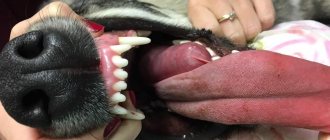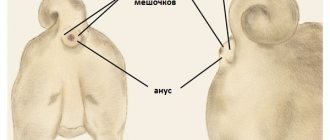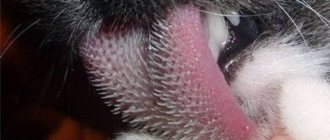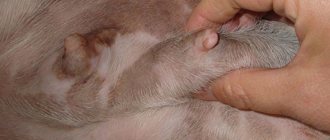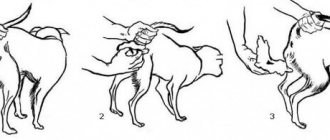The body of almost all dog breeds is covered with hair.
Wool is a kind of barrier between the dog's body and the environment. It can be compared to a thermos: in winter it helps to retain heat, in summer it protects against overheating. But, unfortunately, if the heat is too long, the heat remains in the body and it becomes very difficult to get rid of it due to the fur that prevents cooling. A natural way of thermoregulation is sweating. During this process the body cools down. But the question is: do dogs sweat? Yes, they sweat, but it happens differently for them than for people.
General information
There are two types of sweat glands in a dog's body:
- The first type helps cool the body, the second type does not.
- The second type is the main one in dogs and is called apocrine.
Any hair on a dog's body contains an apocrine gland. This sweat gland has another property - it releases hormones through which dogs transmit information to each other. But these sweat glands do not help remove moisture through the skin, which could help reduce a dog's body temperature. The sweat coming out through the apocrine glands is of an oily consistency. It has no smell. But when it encounters skin bacteria, it develops an odor.
The first type of sweat glands is called merocrine. In dogs, this type of gland is located on hair-free skin, namely on the pads of the feet and on the nose. The sweat produced by these glands consists of water and sodium chloride. Areas of the skin that are free of hair have the ability to remove moisture through the eccrine glands. This can only happen when the body heats up.
Techniques for preventing overheating
To prevent your dog from getting heatstroke, you must follow simple preventive measures:
- When going for a walk, always take water with you to drink, you can also moisten your wool with it;
- walk your pet in a shady area;
- do not abuse physical activity at high ambient temperatures;
- do not use tight muzzles;
- reduce the size of your morning meal.
Attention! In summer, you can’t cut your dog’s hair very short. Ultraviolet rays negatively affect the skin of the animal.
Thermoregulation of dogs
Any living organism controls its body temperature with the help of the brain. There are cold-blooded and warm-blooded animals. Dogs are warm-blooded animals, just like cats, which maintain the desired body temperature. In fact, dogs do not sweat like humans, although they do have glands on their bodies that resemble sweat glands.
They are located on the muzzle, namely on the nose, and on the paws between the toes and on the pads of the toes. The liquid released from the glands on the paws dries quickly and refreshes. She has no smell. The secretion coming out of the glands on the muzzle has a thicker consistency and smell. This is what gives rise to the smell of wet dog.
REFERENCE! You can understand that a dog is sweating only by seeing wet marks from its paws.
Dogs know how to cool down differently. To do this, they stick out their tongue and breathe quickly through their mouth. When they are hot, the dog's body temperature increases. In addition to the temperature, salivation begins to increase. You may also notice your nose and eyes are wetter than usual. Saliva tends to evaporate quickly due to its salt content, which cools the dog's mouth.
REFERENCE! When a dog breathes through his mouth with his tongue hanging out, his nose and ears become cold. This is explained by an increase in capillaries and rapid cooling of surfaces. Due to the faster heart rate, blood passes through the vessels faster and cools.
Due to increased salivation, the body spends salts and electrolytes, and this in turn inhibits the breakdown of carbohydrates, which are the main source of heat. And since they are not absorbed, the dog’s body cools down faster.
Do dogs sweat?
Dogs sweat, but not in the same way as humans. Although sweat glands are designed to help cool humans, things work a little differently in dogs. Dogs have sweat glands, but they are much smaller than humans, and their skin is covered in fur, so this minimizes cooling by sweat.
The two glands where dogs can sweat are the endocrine and apocrine glands.
When your dog gets too warm, he will begin to produce sweat. Apocrine glands are used as a form of social interaction. Although they are technically sweat glands, they do not produce sweat. Distributed throughout the body, the spots release pheromones that our students use to identify each other. Instead of using them for cooling.
Overheating dogs
Thermoregulation is a natural process, so it always works if the dog is absolutely healthy. If a dog is sick, it cannot cope with the increase in body temperature on its own and may overheat and even die.
Overheating can cause:
- - the dog has a fever in response to an infection or virus;
- — the dog has experienced severe stress or excitement;
- — increased air temperature;
- - keeping the dog near heating devices or a fire;
- - keeping the dog in the car in the heat;
- - hard, exhausting workouts in the warm season;
- - lack of water, as a result - dehydration;
- - inability to hide from direct sunlight.
IMPORTANT! The standard temperature for dogs is 38-39 degrees.
You can talk about a dog overheating only after measuring its temperature. If the temperature is still higher than standard, the dog must be left alone in a cool room for 15-20 minutes. If your dog experiences vomiting, excessive salivation, pupils of different sizes, dizziness and other uncharacteristic conditions, you need to quickly provide the necessary first aid and get to the veterinarian as soon as possible.
Overheating symptom
You can tell if your pet is overheating by the following signs:
- severe shortness of breath;
- redness of the mucous membranes;
- thick saliva;
- dehydration;
- development of acute renal failure;
- cardiopalmus;
- convulsive contraction of the muscles of the limbs;
- general weakness, apathy, severe drowsiness;
- refusal to eat;
- muscle tremors;
- prolonged diarrhea;
- vomiting, blood clots may be present in the vomit;
- impaired coordination of movements;
- state of shock.
In the absence of timely assistance, coma may occur, and then death.
To prevent heatstroke, your dog needs help cooling its body.
Other cooling methods
Dogs don't sweat as much as people. This happens due to the fact that more often the dog’s body cools itself with the help of its tongue. If a dog gets hot, it will stick out its tongue and pant rapidly. In hot weather, dogs make about 400 respiratory cycles, in normal weather - only about 40 cycles. Air is inhaled through the nose and moisture comes out of it, after which warm air comes out through the mouth.
As a result, the nose becomes cold. In addition, due to the fact that saliva evaporates, the tongue also cools. Then the blood that passes through the tongue also cools.
The spleen controls the dog's body temperature. It is quite large and due to this, a decent amount of blood can be stored in it, which, if necessary (when the body heats up), can be released. At the base of a dog's neck there are many small veins and arteries that separate the head from the body. Therefore, the brain, which is very sensitive to high temperatures, is protected from extreme heat. For these reasons, dogs are more resilient than humans and many other animals.
How to cool your dog down in the heat
Dog owners should remember that it is forbidden to leave them in a closed car at high temperatures.
First aid for a pet in case of overheating is to lower the body temperature. The wool is moistened with cool, but not cold water (puppies - only warm). The dog should be kept cool at all times - indoors with a fan or air conditioning, or in the shade.
The animal needs to measure its rectal temperature every 5 minutes. As soon as it drops to normal levels, first aid measures must be canceled and the pet must be covered with a blanket so that the body does not continue to lose heat.
Attention! At the first opportunity, the dog should be shown to a veterinarian as quickly as possible, even if its condition has been normalized.
A dog's heat exchange is not perfect, which is why heat stroke can occur in the summer heat. Overheating, without assistance, often ends in irreversible processes in the body or the death of the pet. At high temperatures outside, it is important to take precautions and try not to walk your pet under the scorching sun.
Dog's nose.
The nose is always moist and cool to the touch. It is hot and dry only in two cases. If the dog is sick and if she is very tired and sleeping. A dog recognizes a lot of smells and receives basic useful information with their help. Dogs have excellent hearing and they hear the slightest rustle, turning their ears towards the sound like locators. The vocal cords are adapted to produce various sounds. Many trainers successfully teach dogs to imitate the simplest words. For example, “mother”.
“Dog noses are specially designed to do a much better job than ours,” explains Michael T. Nappier, DVM, DABVP, of the Virginia Maryland College of Veterinary Medicine. “They have up to 300 million olfactory receptors in their nose, versus only about 6 million in ours. And the part of their brain dedicated to their interpretation is about 40 times larger than ours." www.petmd.com
A dog's nose has two functions - one for smell and one for breathing. According to Nappier, a dog's nose has the ability to separate air. Part goes directly to the olfactory region (which distinguishes odors), while the other part is intended for breathing.
You can read how much a dog should drink by following the link.
News edited by: maugli
— 26-11-2019, 22:22
Why do dogs overheat?
The process of thermoregulation is inherent in a dog by nature and is an unconditioned reflex; it always works... if the dog is healthy. If the pet is unwell and cannot cool itself down, an increase in temperature can lead to overheating and even death. Overheating can result from:
- Fever is an increased body temperature as a response of the immune system to a virus or infection.
- Strong excitement, stress, fear.
- High air temperature.
- Active training in summer.
- Staying close to fire, heaters, etc.
- Staying in a closed, unventilated space, such as a car.
- Dehydration, lack of access to a drinking bowl, hot water in the drinking bowl in the heat.
- Lack of ability to hide from direct sunlight in summer.
Note! A dog's normal body temperature ranges from 38 to 39°, depending on the age and size of the four-legged dog. Miniature puppies have a maximum threshold of 39.4°.
In a state of heatstroke, the dog's body is exposed to a kind of poisoning. Thickened blood does not circulate well throughout the body, which slows down the process of eliminating toxins. In addition, high temperature increases the risk of blood clots or exacerbation of illnesses. Dogs with the following problems/traits are more prone to heatstroke:
- Blunt, short, upturned muzzle (brachycephalic).
- Heart failure.
- Respiratory failure.
- Old or too young.
- Excess weight!
- Dense fur, uncombed undercoat.
- Dark color.
- Any infectious or viral process.
Important! Judging about overheating can only be done after recording body temperature, since the symptoms are very individual and similar to other, no less dangerous conditions.
If you suspect overheating, you should measure the dog's body temperature; if it is elevated, the action algorithm is as follows: place the dog in rest and coolness for 20 minutes, and if the following symptoms appear or worsen, provide first aid and immediately consult a doctor:
- Dizziness, unfocused gaze, sluggish accommodation of the pupils, pupils of different sizes.
- Disorientation in space, unsteady gait, the dog drops its head or tilts it to the side.
- Vomiting, severe salivation.
- Pale mucous membranes of the mouth and eyelids.
Note! An increase in symptoms indicates the manifestation of a so-called true fever, which the body cannot overcome on its own!
A true fever that goes untreated can kill a dog, and the chances of death are quite high. While waiting for the veterinarian or on the way to the clinic, you can help your pet:
- By offering or forcefully drinking cool water.
- Wrap the dog in a damp towel.
- Apply a damp cloth to your ears.
- By injecting/drinking any antipyretic (non-toxic for dogs). Analgin with diphenhydramine is optimal, but if such drugs are not available, any children's syrup or injectable drug will do.
Do you know what a dog's normal body temperature is? In the range from 37.5 to 39 0 C. Slightly higher than in humans. The temperature norm is individual for each breed, age and weight of the animal. Please note that the dog does not sweat. This means that in the heat, “friends of man” have a very hard time. During physical activity, a dog's body temperature rises significantly, almost instantly. And the only way to cool down is the evaporation of moisture, which occurs from the protruding tongue. Yes, yes, that’s why dogs run, usually with their tongues hanging out and breathing very intensely.
However, quite numerous cases have been recorded when dogs stoically endured the heat, accompanying a person on his expeditions through the desert and other hot areas of our planet. Of course, from contact with hot sand or stone, the animals’ paws received serious burns, but this did not prevent the dogs from not only surviving, but also serving for the benefit of humans as they should be.
The phenomenon when the body is cooled due to the evaporation of moisture from the surface of the tongue during very rapid breathing (up to 400 breaths/exhalations per minute) is called thermoregulatory panting.
Panting (increased breathing) is always a consequence of an increase in the dog's body temperature. Both long-haired and short-haired dog breeds tolerate heat equally poorly. We should also not forget that for northern dog breeds, such as the Laika, the climate of central Russia and the south of Russia is not very suitable, although it is not directly destructive.
Structure
Sweat glands are simple tubular channels that are formed in the epithelial layer of the skin. The ducts have a spiral-shaped secretory section. Sweat accumulates in it, then it is brought to the surface of the skin. Such sweat centers are located everywhere: in the armpits, on the soles of the feet, on the forehead, palms, groin, etc.
Until some time, there were some difficulties in studying the structure and functions of the sweat glands. But a team of scientists led by Kiyotoshi Sekiguchi and Ryuichiro Kurata from Osaka University invented and applied a special immunostaining technique. This made it possible to thoroughly study how all the structures of the sweat gland function and interact with each other. In the future, this knowledge will make it possible to identify and treat many pathologies associated with increased sweating.
When examining the sweat glands under a microscope, you can see human sweat pores (openings) and special cells in the walls of the tubes for the synthesis of sweat secretion. The tubules, together with the ducts of the sebaceous centers, partially flow into the hair roots (hair follicles). The anatomical structure of the sweat gland consists of:
- body - secretory spiral tube;
- output channel;
- pores.
Around the secretory tangle there are small capillaries that densely entwine it and supply blood to each sweat gland. There is also a dense network of nerve receptors. Thanks to this structure, the regulation of the activity of glandular centers is carried out under the control of the nervous system. The function of the sweat glands is also regulated by hormones of the adrenal cortex.
The sweat glands begin to function with the release of secretions through the pores, especially actively when the nerve receptors are irritated. Typically, this reaction occurs to heat, quantitative surges of hormones, stress, and dangerous situations.
The number of sweat glands in human skin varies in the range of 2-3 million. Consequently, in every 1 cm of the palm or sole of the foot there are 300-400 microtubules for sweat removal. Most of the glandular centers that secrete sweat are located in the skin of the forehead, armpits, and groin. Fewer tubules are located in other parts of the body. There are no glandular sweat tubes only in the skin of the lips and some areas of the genitals.
The main significance of the glandular centers is thermoregulation, which at the right time corrects the temperature of the internal organs and skin. Sweating centers work at different rates, which depend on the environment. If you are completely immobile in a cold room, not all glands will work.
Men sweat more than women. The chemical composition of the secreted liquid during sweating is individual and differs depending on the location of the secretory gland.
Animals sweat to cool off
What do dogs sweat through ? When sweat comes out through the paws, it helps the dog cool down, but it is more effective when he breathes quickly. People sweat to regulate body temperature, as the evaporation of moisture allows the body temperature to decrease. Animals do this differently because instead of sweating, their bodies try to neutralize moisture through saliva, so they use panting as a cooling mechanism. That's why people say that dogs sweat with their tongues .
